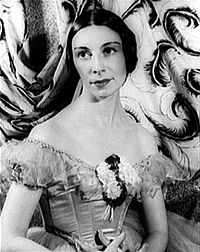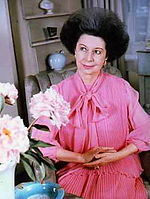- Alicia Markova
-
Dame Alicia Markova DBE 
Alicia Markova in 1940Born Lilian Alicia Marks
1 December 1910
London, United KingdomDied 2 December 2004 (aged 94)
Bath, Somerset, United KingdomNationality British Occupation Ballerina Known for dancing Title Prima ballerina assoluta Dame Alicia Markova, DBE, DMus, (1 December 1910 – 2 December 2004) was an English ballerina and a choreographer, director and teacher of classical ballet. Most noted for her career with Sergei Diaghilev's Ballets Russes and touring internationally, she was widely considered to be one of the greatest classical ballet dancers of the 20th century. She was the first British dancer to become the principal dancer of a ballet company and, with Dame Margot Fonteyn, is one of only two English dancers to be recognised as a prima ballerina assoluta. [1] [2] [3] [4] [5] She was a founder dancer of the Rambert Dance Company, The Royal Ballet and American Ballet Theatre, and was co-founder and director of the English National Ballet.
Contents
Biography
Early years
Markova was born as Lilian Alicia Marks [6] on 1 December 1910. Her father, Alfred Marks, was Jewish and her mother Eileen converted to Judaism.[7] They lived in a two bedroom flat in the Finsbury Park district of London.[8]
Markova began to dance on medical advice to strengthen her weak limbs. She made her stage debut aged 10, performing the role of Salome in the pantomime Dick Whittington and His Cat, for which she was billed as Little Alicia, the child Pavlova.[9]
She then began studying ballet with Princess Serafina Astafieva, a Russian ballerina living in London. Astafieva was a retired dancer of the Ballets Russes, a renowned ballet company founded by the impresario Sergei Diaghilev. Astafieva established the Russian Dancing Academy at The Pheasantry on King's Road in Chelsea and was responsible for teaching a number of notable British dancers including Marie Rambert, Margot Fonteyn and Anton Dolin. A blue plaque now marks the site of her former studio.[10]
Diaghilev's Ballets Russes
At the age of 13, Markova was observed in class by Diaghilev, who was visiting London in search of new talent for his ballet company. He invited her to join the Ballets Russes in Monte Carlo, which she did in 1925, one month after her 14th birthday. Due to her age, she performed a number of roles which were specially choreographed for her, also performing in a varied repertoire of new and established ballets. Alongside the many notable dancers, during this period she encountered a number of leading 20th century figures who created work for the company including the artists Pablo Picasso and Henri Matisse, composers including Igor Stravinsky and Sergei Prokofiev and a number of leading choreographers including Léonide Massine, George Balanchine, and Bronislava Nijinska.[11] Markova was interviewed about these years in the documentary Ballets Russes.
After Diaghilev
Following the death of Diaghilev in 1929, Markova returned to England, where she became the founder Principal Ballerina of The Ballet Club, a company founded by Dame Marie Rambert. During this period, she was particularly noted for performing works by Frederick Ashton, who was unknown at the time, but would go on to become one of Britain's most celebrated choreographers. The Ballet Club was to be the first professional ballet company in the United Kingdom, later becoming known as the Ballet Rambert. Now known as the Rambert Dance Company, it remains the oldest established dance company in the U.K.
In 1931, Dame Ninette de Valois founded the Vic-Wells Ballet in premises at Sadler's Wells theatre in London. A former colleague from Diaghilev's company, she invited Markova to join the company as one of its founder dancers, which she did, forming a famous partnership with Sir Anton Dolin. De Valois also hired Frederick Ashton, who became the resident choreographer and later Artistic Director of the company. In 1933, de Valois appointed Markova as the first Prima Ballerina of the company, which is now the internationally renowned Royal Ballet.
It was after seeing the Camargo Society performance of Giselle with Olga Spessivtseva and Dolin in 1932 that Markova first realized the possibilities of the then-neglected ballet. In time it became her most treasured role and the one whose expressive possibilities she continued to develop throughout her career. Her premiere in the role was on New Year's Day 1934 at the Vic.[12]
In 1935, Markova and Dolin left the Vic-Wells ballet to form their own touring company known as the Markova-Dolin Company. The company toured extensively for two seasons and in 1936 Prince Wolkonsky joined the company as ballet master. Later in 1938 Markova joined the Ballet Russe de Monte Carlo, touring the world as the company's star ballerina. The company was the first to tour ballet throughout the United States, taking the art form to audiences who had never seen ballet before. During this time, she was also a key figure in the formation of the American Ballet Theatre, dancing with the company during its early years.[13] Markova appeared in ballets around the world, but is remembered mostly for her Giselle, as well as for The Dying Swan and Les Sylphides. During the Second World War she re-formed Les Ballets Russes in the United States and also appeared as a dancer with Dolin in the Hollywood film A Song for Miss Julie.[14] She turned down the offer to play Anna Pavlova in a feature film.[15]
English National Ballet
In 1950, Markova and Dolin became the co-founders of the Festival Ballet, a company formed to celebrate the imminent Festival of Britain and backed by the Polish businessman Julian Brunsweg. Dolin was to be the company's first Artistic Director, with Markova as Prima Ballerina. The company was formed to tour ballets to audiences that would otherwise be unable to experience ballet, and went on to tour extensively to less conventional venues both in the United Kingdom and internationally. It also established a number of educational programmes designed to make ballet accessible to new audiences.[16] Markova remained the Prima ballerina of the company until 1952, after which she continued to appear regularly as a guest dancer until her retirement from professional dancing. In 1989, the Festival Ballet was renamed English National Ballet to reflect the company's role as Britain's only classical ballet company dedicated to touring ballets nationwide at an affordable price for audiences.
Retirement
Markova retired from professional dancing in January 1963 at the age of 52. Following her retirement, she continued to play an active role in the ballet and theatre industry as a teacher, director and choreographer. She was responsible for staging a number of ballets that she had performed with the Ballets Russes, also coaching dancers for roles she had created for choreographers such as Sir Frederick Ashton. As a teacher she has presented televised master classes and was also appointed Professor of Ballet and Performing Arts at the University of Cincinnati. In her later years, she continued to be a regular member of the teaching faculty for residential ballet courses such as the Yorkshire Ballet Seminars and the Abingdon Ballet Seminars, and was also President and a regular guest teacher at the Arts Educational Schools in London and Tring. She was also a governor and regular guest teacher at the Royal Ballet School.[17]
Markova was also the Patron and President for numerous dance organisations, including serving as President of English National Ballet, a Governor of The Royal Ballet and vice President of the Royal Academy of Dance.
Death
Some time after suffering a stroke, Dame Alicia died on 2 December 2004 in a hospital in Bath, Somerset, one day after her 94th birthday.
A memorial service of thanksgiving for her life and work was held at Westminster Abbey on 8 March 2005. As part of the service, dancers of the English National Ballet company performed extracts from the ballet Giselle (Daria Klimentová, Dmitri Gruzdyev, Erina Takahashi, Arionel Vargas) and Les Sylphides (Agnes Oakes and Simone Clarke).[18]
Prior to the thanksgiving for her life, Dame Alicia Markova had a Funeral Service at Bath's Haycombe Crematorium.
Awards, titles and honours
- 1957 - Dance Magazine Award
- 1957 - Woman of the Year Award (American Women's Organisation)
- 1958 - CBE, Commander of the Order of the British Empire
- 1963 - DBE, Dame Commander of Order of the British Empire
- 1963 - Queen Elizabeth II Coronation Award, Royal Academy of Dance
- 1966 - DMus, Honorary Doctorate of Music, Leicester University
- 1982 - MusD, Honorary Doctorate of Music, University of East Anglia
- 1994 - Evening Standard Special Award
- 2000 - Cecchetti D'Argento Award, Imperial Society of Teachers of Dancing
- 2001 - DUniv, Honorary Doctor of the University, Middlesex University
Positions
- Co-Founder and President, English National Ballet
- Governor, The Royal Ballet
- Vice President, Royal Academy of Dance
- President, The London Ballet Circle
- Patron, The Academy of Indian Dance
- President, All England Dance Association
- President, The Arts Educational Schools
- President, British Ballet Organisation
- Professor of Ballet and Performing Arts, College-Conservatory of Music, University of Cincinnati
- Patron, Friends of Northern Ballet Theatre
- Patron, Abingdon Ballet Seminars
- Honorary President, ANCEC (Associazione Nationale Coreutica Enrico Cecchetti)
- Patron, Critics' Circle National Dance Awards
See also
- List of British Jews
- Alicia Markova "The Dying Swan"
References
- Bibliography
- "Alicia Markova and Anton Dolin: a legend of British ballet: a collection of portraits"; foreword by Peter Williams
- "Alicia Markova" by Hugh Fisher
- "Markova: a collection of photographic studies by Gordon Anthony"; foreword by Dame Ninette de Valois
- "Markova: her life and art", by Sir Anton Dolin, 1953
- "Giselle and I", Dame Alicia Markova DBE, 1961
- "Markova Remembers", Dame Alicia Markova DBE, 1986
- "Markova: The Legend", Maurice Leonard, 1995
- Notes
- ^ As per Jane Pritchard, archivist for English National Ballet
- ^ Article from the Royal Academy of Dance
- ^ The Telegraph, 3 December 2004
- ^ Mary Clarke and David Vaughan (eds) 1977. The encyclopedia of dance & ballet. Pitmans: London, p. 228
- ^ The Guardian, 3 December 2004
- ^ Some sources indicate that Markova was born as Alicia Lilian Marks
- ^ "Dame Alicia, the woman who brought ballet to the people, dies at 94."
- ^ Obituary in The Guardian, Friday 3 December 2004
- ^ Dolin, Ch 2; Leonard, Ch 3
- ^ Dolin, Ch 3; Leonard, Ch 4
- ^ Dolin, Ch 4; Leonard, Ch 5 - 8
- ^ Dolin, pp. 183 - 195; Markova, "Giselle and I"
- ^ Dolin, Ch 12; Leonard, Ch 16
- ^ Leonard, p. 241
- ^ Leonard, p. 151
- ^ Leonard, Ch 20
- ^ Leonard, Ch 24
- ^ "Markova Memorial - Westminster Abbey"
External links
- Bio of Markova at Ballet.co.uk
- Dame Alicia Markova obituary
- The Ballerina Gallery - Alicia Markova
- Andros on Ballet - Alicia Markova
- London Ballet Circle
- Alicia Markova dances - actual clip
- English National Ballet - Dame Alicia Markova, Ballet.org
- Obituary: Dame Alicia Markova Brilliant prima ballerina Yorkshire Post, December 4, 2004
Categories:- 1910 births
- 2004 deaths
- English Jews
- Deaths from stroke
- English National Ballet
- Ballets Russes dancers
- Dancers of The Royal Ballet
- Ballet Russe de Monte Carlo dancers
- English ballet dancers
- Dames Commander of the Order of the British Empire
- Prima ballerina assolutas
Wikimedia Foundation. 2010.


